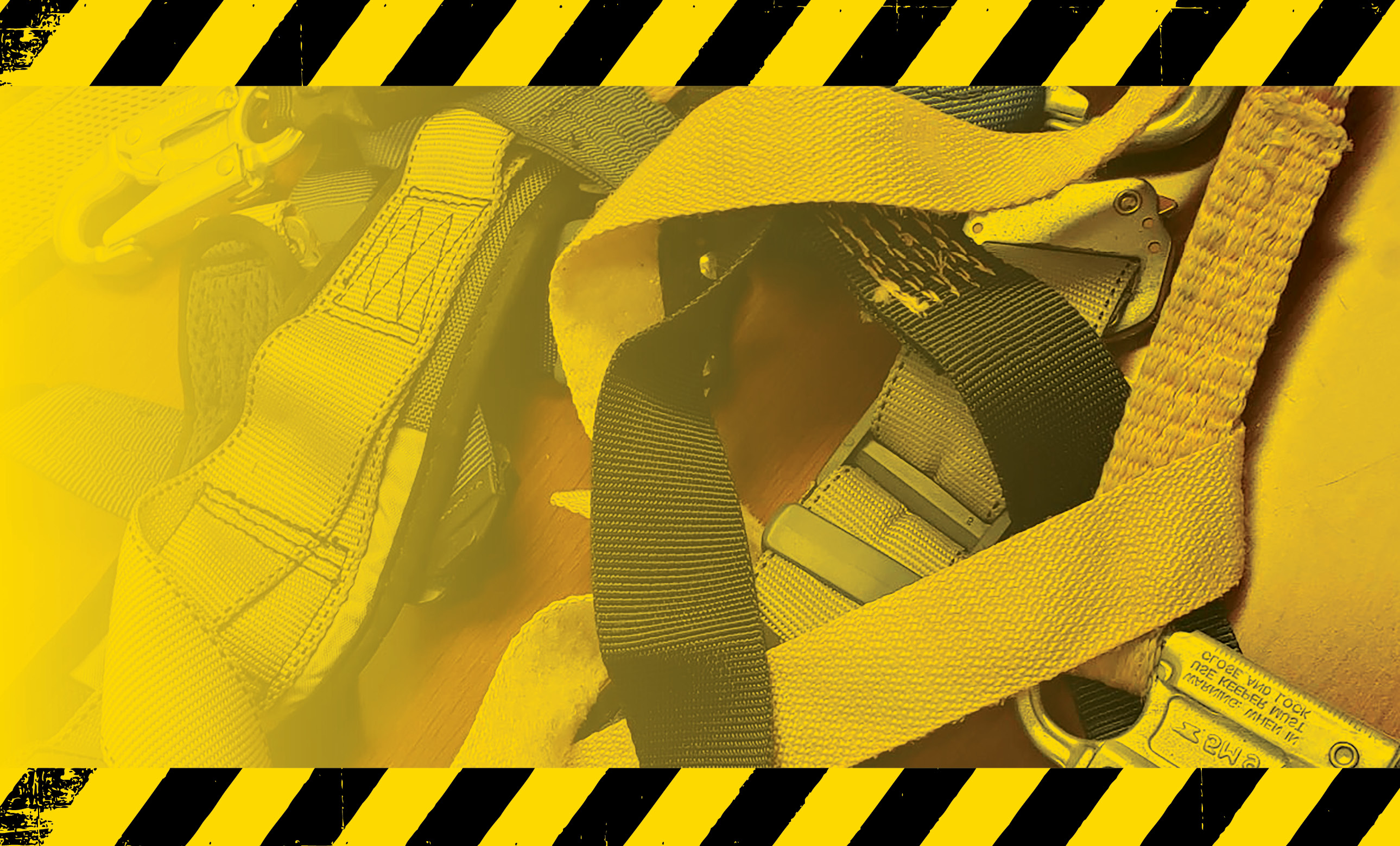
Roofing workers face numerous hazards daily, and falls are among the most significant. Falls from heights can result in severe injuries or even fatalities, making fall prevention a top priority for roofing contractors. Thankfully, there are various strategies and measures you can incorporate to ensure your workers remain safe from falls.
Prevention > protection
The term “fall protection” has largely been synonymous with preventing falls. However, a device such as a personal fall-arrest system actually permits a worker to fall. With proper use and application, these devices slow a worker’s fall to a stop, preventing him or her from landing upon a lower level. When such an event occurs, the fall-arresting force placed on the body can be 900 pounds or more.
Fall prevention, on the contrary, is planning work—whenever possible—so falls are prevented. Through fall-prevention planning, workers do not have the potential to endure fall-arresting forces.
For example, falling through roof decks is an increasing problem leading to serious injuries and fatalities. Fall-prevention measures such as roof deck integrity assessments and proper loading of the roof structure can decrease the incidence of these types of falls.
With the roofing industry continuing to lead other professions in deaths and injuries from falls, it is time to refocus on fall prevention and not just protection.
Stats and trends
According to the latest data from the Bureau of Labor Statistics, there were 986 fatalities in the U.S. construction industry in 2021 of which 390, or 39%, were directly related to falls. During the same year, there were 123 fatalities in roofing with 99 resulting from falls. This means 25% of the fatal falls in construction are attributed to the roofing industry.
Canada is experiencing similar tragic statistics with falls continuing to be a leading cause of death and injury in construction and its roofing industry. A recent analysis of 92 fatal falls from heights in Ontario between 2009 and 2016 found of the 60 fatal falls in construction, 35% were attributed to roofing contractors.
This year, the Occupational Safety and Health Administration created a new national emphasis program on falls in construction and increased enforcement. In September 2023, OSHA issued $548,801 in proposed penalties to an Ohio roofing contractor for repeatedly exposing workers to fall hazards higher than 6 feet.
Data from CNA Insurance Cos., Chicago, indicates better than industry statistics for falls over the edge. However, there has been a marked increase in falls through roof decks, skylights and other openings, broadening concern about this trend.
Underlying causes
CPWR-The Center for Construction Research and Training took a closer look at falls from heights in construction. A 2022 survey revealed the following key findings:
- In almost half of all falls, no fall protection was used.
- Twenty-seven percent of respondents identified “insufficient or ineffective planning as the primary cause of falls from heights.”
- Lack of planning also was associated with a 71% lower likelihood of using fall protection.
- Respondents strongly associated the use of fall-protection equipment with employee beliefs and understanding of their company’s fall-protection policy and as a result were eight times more likely to use fall protection when they believed it was required by their employer.
- Rescue training reduced the odds of a fatal fall by 76% for those who had received training compared with those who had not received training.
Similar parallels were found in Canada. When examining falls from heights in Ontario from 2009-16, the most common factors contributing to fatalities were lack of worksite instruction, lack of falls training, and not wearing personal protective equipment or wearing it improperly. Even more concerning, in the fatalities where training was evident, the most common factors were still the same: lack of training and not wearing or improperly wearing PPE.
Additionally, the increase in falls through roof decks can be attributed to poor deck integrity. Assessing the integrity and load-bearing capability of a roof deck is a critical step in properly bidding a project and safely sending workers onto the roof to remove an old roof system, perform repairs or install a new system. OSHA requires workers only work on surfaces that have the “strength and structural integrity” to support them.
Hierarchy of controls
The preferred solution for fall prevention in the hierarchy of controls is to eliminate exposure to the fall hazard. But given the nature of roofing work, that is not a likely scenario. Next on the hierarchy of controls is passive fall-protection measures that include physical barriers such as guardrails around unprotected sides and edges and secured covers over holes and skylights.
The third level on the hierarchy of controls is the use of fall-restraint systems that use PPE, including a harness, lanyard and anchor point. When properly rigged, the PPE will restrict a worker’s range of movement so he or she cannot fall.
Finally, fall-arrest systems, which allow a worker to fall but arrest the fall within acceptable force and clearance margins, constitute fall protection. Fall-restraint and fall-arrest systems require specific training; fall-arrest systems also require rescue planning.
PtD
Prevention through design (PtD) emphasizes integrating safety measures into the design and planning of roofing projects. This proactive approach ensures safety considerations are incorporated from the outset, minimizing the need for last-minute retrofitting or post-construction safety measures.
In its 2022 survey, CPWR highlighted that engaging in fall-prevention planning can help employers target the most effective levels of the hierarchy of controls and employ methods such as PtD to design fall prevention into buildings, job sites and workflow for safety.
CPWR also noted additional research regarding how to get more employers to provide and use fall protection, particularly smaller companies, is needed. Furthermore, it noted exploration about how to support fall-protection planning among small employers and subcontractors with limited resources could help lessen the gap between employer groups in fall outcomes.
A great example of integrating safety measures into the design and planning of roofing projects to prevent fall-throughs is performing a roof deck integrity assessment by taking some important steps:
- Determine whether the underside of the roof deck is accessible and can be viewed for inspection.
- Observe signs of water intrusion such as wet insulation, water damage or discoloration to interior materials or surfaces.
- Ensure proper fall-protection measures are taken during assessment in the event of a deck failure.
- Do a thorough assessment depending on roof deck type (wood, steel, concrete, etc.). You may want to consider using an independent structural engineering company or consultant to perform an inspection and provide a written report.
- Document findings and include photos and videos. Roofs that are suspect require the findings and any considerations for fall protection are communicated to the appropriate parties, including building owners, general contractors and subcontractors.
Safety is good business
Roofing contractors must not short-change safety by excluding safety considerations in roofing bids and estimates. Ensuring safety affects legal compliance, worker well-being, reduced liability, lower insurance costs and enhanced reputation. Safety pre-planning also provides other benefits such as quality of work, long-term cost savings, preventing job delays caused by safety accidents, environmental considerations and ethical responsibility.
In fact, in a recent letter, OSHA reminded restoration and roofing contractors who perform insurance claim work to ensure they are accounting for safety requirements in their project estimates while working at elevations, including but not limited to siding, window and gutter repair. OSHA stressed insurance adjusters and insurance companies should include safety costs in the cost estimates for claims work so as not to create a disincentive for complying with OSHA standards that apply to this type of work.
Safety compliance is more than a moral responsibility; it’s a legal requirement. Contractors must adhere to local, state and federal safety regulations. Failing to do so can lead to costly fines, legal troubles and potential project shutdowns.
Incorporating safety measures also can help reduce liability. When accidents happen on jobs as a result of inadequate safety precautions, roofing contractors can be held legally responsible for the resulting injuries or damages. By proactively addressing safety concerns in bids, contractors can reduce their liability exposure.
Implementing comprehensive safety measures also may lead to lower insurance premiums. Insurers often offer discounts to contractors who demonstrate a strong commitment to safety. Contractors who include safety considerations in bids and estimates may secure better insurance rates, ultimately reducing project costs.
In addition, a commitment to safety can enhance a contractor’s reputation. Clients and partners are more likely to trust and choose contractors who prioritize safety. This can lead to more business opportunities and referrals.
NRCA safety training
Be sure to register for NRCA’s Safety Leadership Workshop Tuesday, Feb. 6, during NRCA’s 137th Annual Convention and the 2024 International Roofing Expo.® For more information and to register, visit theroofingexpo.com.
NRCA has other resources to help roofing contractors create safe work environments and job sites, such as:
- Fall-protection Trainer Course for Roofing
- Roofing Industry Fall Protection from A to Z
For more information, contact Rich Trewyn, NRCA’s director of risk education and training, at (847) 493-7575 or rtrewyn@nrca.net, or visit nrca.net.
Accidents and injuries can lead to project delays, resulting in increased costs and dissatisfaction among clients. By including safety in bids and estimates, contractors can plan for safety measures upfront, reducing the likelihood of disruptions to the project timeline.
Safety measures often result in quality workmanship. Properly trained and equipped workers are more likely to produce high-quality results. This can lead to increased client satisfaction and repeat business.
Although safety measures may add upfront costs to a roofing project, they can lead to significant cost savings in the long run. Preventing accidents and injuries reduces medical expenses, workers’ compensation claims and potential legal fees.
Safety measures also can encompass environmental concerns. Proper disposal of materials, use of eco-friendly products and adhering to environmental regulations can minimize a roofing project’s environmental effects.
Beyond legal and financial considerations, roofing contractors have an ethical responsibility to protect the safety and well-being of their workers, clients and the community at large. Prioritizing safety in bids and estimates aligns with ethical business practices.
SMALLER COMPANIES
Although larger roofing companies may have more resources to implement comprehensive safety measures, small-sized contractors often encounter heightened risks because of limited resources, varied work environments, multitasking and less oversight.
Roofing projects can differ significantly because of diverse roof system designs, materials and working conditions. Smaller roofing crews may require workers to multitask, increasing the chances of overlooking safety protocols. With fewer supervisors and safety personnel, small-sized contractors may struggle to maintain rigorous safety standards.
Improving safety culture for residential and small-sized contractors can go a long way in reducing incidents related to falls. Smaller-sized contractors should:
- Develop training programs specifically designed for small contractor crews and focus on practical, cost-effective safety measures applicable to the types of projects undertaken.
- Collaborate with industry organizations and larger roofing companies to assist with access to resources, including safety manuals, guidelines and affordable safety equipment.
- Establish mentorship programs where experienced roofing workers from larger companies can share expertise with smaller contractor teams, emphasizing safety practices.
- Form safety communities through alliances or consortiums among smaller contractors to share resources and knowledge, enabling a collective commitment to safety.
- Explore grants, subsidies and incentives provided by local governments or industry associations to support small contractors in acquiring safety equipment and training.
- Consider hiring safety consultants or experts on a part-time or contract basis to provide guidance and ensure adherence to safety standards. Conduct frequent safety audits and inspections to identify hazards and implement corrective actions promptly.
- Foster a culture of safety not only within the organization but also within the local community and encourage homeowners to hire contractors who prioritize safety.
These efforts can pay positive dividends, including enhancing reputations and reducing fall injuries and deaths.
In an industry where safety is paramount, small-sized contractors can thrive by prioritizing the well-being of their workers and their clients’ satisfaction. By tailoring training, accessing resources, fostering mentorship and embracing safety communities, smaller contractors can enhance their safety culture and mitigate the risks of falls.
Build a safety culture
The importance of fall prevention in roofing and the vital role of a robust safety culture in enhancing safety measures and reducing accidents cannot be overemphasized. Effective safety culture starts at the top. Company leadership should be actively committed to safety, setting the tone for the entire organization.
Workers should be encouraged to actively participate in safety initiatives. Their input is invaluable for identifying hazards and improving safety practices. Workers know the challenges, and leveraging their capacity to problem-solve and be resilient can have a huge effect on safety culture.
Comprehensive training programs should be provided to all employees, emphasizing safety procedures, equipment usage and hazard recognition. Companies should establish clear lines of accountability for safety, ensuring all team members understand their roles and responsibilities.
Open, transparent communication channels should exist for reporting hazards, near-miss incidents and safety concerns. Workers should feel comfortable speaking up. If they don’t, figure out where the roadblocks exist and work to break the stigma that may be preventing workers from speaking up.
Recognize and reward employees for their safety efforts and achievements. This positive reinforcement encourages a safety-conscious mindset. Regularly assess and review safety practices, seeking ways to enhance them. Involve employees in identifying areas for improvement.
Commit to workplace safety
Fall prevention is a legal obligation and moral imperative, safeguarding the lives and well-being of roofing workers. Adopting comprehensive safety measures, thorough training and cultivating a safety-conscious culture can significantly diminish the risk of falls and accidents.
Employers and employees must work collaboratively to create safer working environments, allowing everyone to return home safely at the end of each workday.
CHERYL M. AMBROSE, CHST, OHST, is NRCA’s vice president of enterprise risk management.


